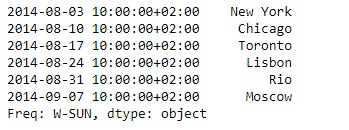Pandas 係列是帶有軸標簽的一維ndarray。標簽不必是唯一的,但必須是可哈希的類型。該對象同時支持基於整數和基於標簽的索引,並提供了許多方法來執行涉及索引的操作。
Pandas Series.slice_shift()函數等效於不複製數據的移位。移位的數據將不包括丟失的周期,並且移位的軸將小於原始數據。
用法: Series.slice_shift(periods=1, axis=0)
參數:
periods:移動的周期數,可以是正數或負數
返回:平移:與調用者類型相同
範例1:采用Series.slice_shift()函數將給定Series對象的數據移動2個周期。
# importing pandas as pd
import pandas as pd
# Creating the Series
sr = pd.Series(['New York', 'Chicago', 'Toronto', 'Lisbon', 'Rio', 'Moscow'])
# Create the Datetime Index
didx = pd.DatetimeIndex(start ='2014-08-01 10:00', freq ='W',
periods = 6, tz = 'Europe/Berlin')
# set the index
sr.index = didx
# Print the series
print(sr)輸出:

現在我們將使用Series.slice_shift()函數將給定係列對象中的數據移動2個周期。
# shift by 2 periods
sr.slice_shift(periods = 2)輸出:

正如我們在輸出中看到的,Series.slice_shift()函數已成功將數據移到索引上。請注意,前兩個索引標簽已刪除。
範例2:采用Series.slice_shift()函數將給定Series對象的數據移動-2個周期。
# importing pandas as pd
import pandas as pd
# Creating the Series
sr = pd.Series(['New York', 'Chicago', 'Toronto', 'Lisbon', 'Rio', 'Moscow'])
# Create the Datetime Index
didx = pd.DatetimeIndex(start ='2014-08-01 10:00', freq ='W',
periods = 6, tz = 'Europe/Berlin')
# set the index
sr.index = didx
# Print the series
print(sr)輸出:

現在我們將使用Series.slice_shift()函數將給定係列對象中的數據移動-2個周期。
# shift by -2 periods
sr.slice_shift(periods = -2)輸出:

正如我們在輸出中看到的,Series.slice_shift()函數已成功將數據移到索引上。請注意,最後兩個索引標簽已刪除,並且數據已向上移動。
相關用法
- Python pandas.map()用法及代碼示例
- Python Pandas Series.str.len()用法及代碼示例
- Python Pandas.factorize()用法及代碼示例
- Python Pandas TimedeltaIndex.name用法及代碼示例
- Python Pandas dataframe.ne()用法及代碼示例
- Python Pandas Series.between()用法及代碼示例
- Python Pandas DataFrame.where()用法及代碼示例
- Python Pandas Series.add()用法及代碼示例
- Python Pandas.pivot_table()用法及代碼示例
- Python Pandas Series.mod()用法及代碼示例
- Python Pandas Dataframe.at[ ]用法及代碼示例
- Python Pandas Dataframe.iat[ ]用法及代碼示例
- Python Pandas.pivot()用法及代碼示例
- Python Pandas dataframe.mul()用法及代碼示例
- Python Pandas.melt()用法及代碼示例
注:本文由純淨天空篩選整理自Shubham__Ranjan大神的英文原創作品 Python | Pandas Series.slice_shift()。非經特殊聲明,原始代碼版權歸原作者所有,本譯文未經允許或授權,請勿轉載或複製。
